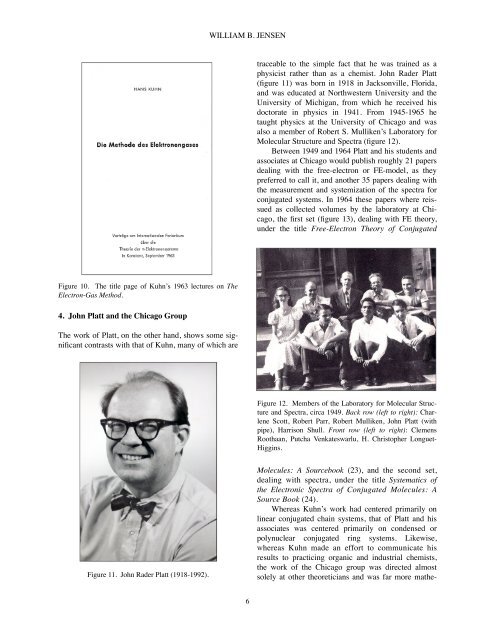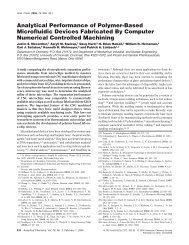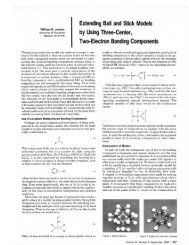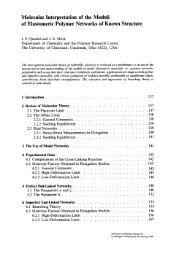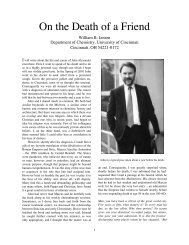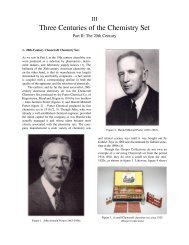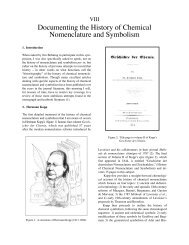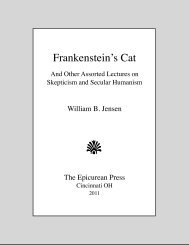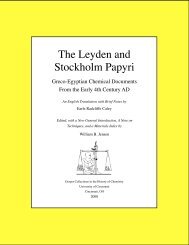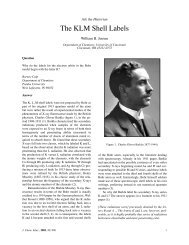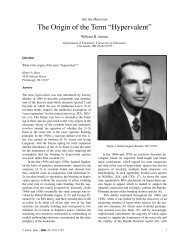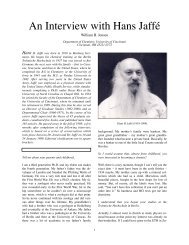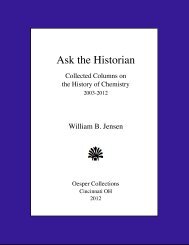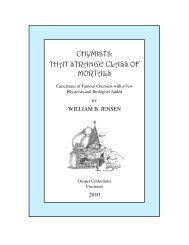198. Free Electron.pdf - University of Cincinnati
198. Free Electron.pdf - University of Cincinnati
198. Free Electron.pdf - University of Cincinnati
You also want an ePaper? Increase the reach of your titles
YUMPU automatically turns print PDFs into web optimized ePapers that Google loves.
WILLIAM B. JENSEN<br />
traceable to the simple fact that he was trained as a<br />
physicist rather than as a chemist. John Rader Platt<br />
(figure 11) was born in 1918 in Jacksonville, Florida,<br />
and was educated at Northwestern <strong>University</strong> and the<br />
<strong>University</strong> <strong>of</strong> Michigan, from which he received his<br />
doctorate in physics in 1941. From 1945-1965 he<br />
taught physics at the <strong>University</strong> <strong>of</strong> Chicago and was<br />
also a member <strong>of</strong> Robert S. Mulliken’s Laboratory for<br />
Molecular Structure and Spectra (figure 12).<br />
Between 1949 and 1964 Platt and his students and<br />
associates at Chicago would publish roughly 21 papers<br />
dealing with the free-electron or FE-model, as they<br />
preferred to call it, and another 35 papers dealing with<br />
the measurement and systemization <strong>of</strong> the spectra for<br />
conjugated systems. In 1964 these papers where reissued<br />
as collected volumes by the laboratory at Chicago,<br />
the first set (figure 13), dealing with FE theory,<br />
under the title <strong>Free</strong>-<strong>Electron</strong> Theory <strong>of</strong> Conjugated<br />
Figure 10. The title page <strong>of</strong> Kuhn’s 1963 lectures on The<br />
<strong>Electron</strong>-Gas Method.<br />
4. John Platt and the Chicago Group<br />
The work <strong>of</strong> Platt, on the other hand, shows some significant<br />
contrasts with that <strong>of</strong> Kuhn, many <strong>of</strong> which are<br />
Figure 12. Members <strong>of</strong> the Laboratory for Molecular Structure<br />
and Spectra, circa 1949. Back row (left to right): Charlene<br />
Scott, Robert Parr, Robert Mulliken, John Platt (with<br />
pipe), Harrison Shull. Front row (left to right): Clemens<br />
Roothaan, Putcha Venkateswarlu, H. Christopher Longuet-<br />
Higgins.<br />
Figure 11. John Rader Platt (1918-1992).<br />
Molecules: A Sourcebook (23), and the second set,<br />
dealing with spectra, under the title Systematics <strong>of</strong><br />
the <strong>Electron</strong>ic Spectra <strong>of</strong> Conjugated Molecules: A<br />
Source Book (24).<br />
Whereas Kuhn’s work had centered primarily on<br />
linear conjugated chain systems, that <strong>of</strong> Platt and his<br />
associates was centered primarily on condensed or<br />
polynuclear conjugated ring systems. Likewise,<br />
whereas Kuhn made an effort to communicate his<br />
results to practicing organic and industrial chemists,<br />
the work <strong>of</strong> the Chicago group was directed almost<br />
solely at other theoreticians and was far more mathe-<br />
6


